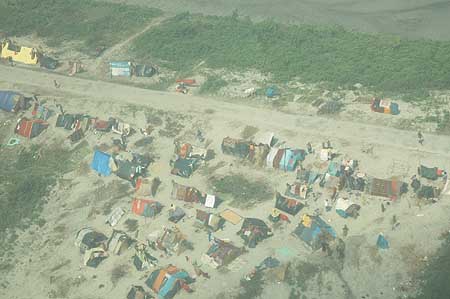Patna, Sep 11 : The Kosi river waters are receding, but the damage it has wrought on agricultural lands in Bihar is sinking in only now. Standing crops of paddy, banana and to some extent maize have been dealt a major blow in what is known as the state's rice basket.
The possibility of vast farmlands turning barren also looms large as the Kosi, which changed course three weeks ago, killing over 50 people and affecting over 2.7 million people, is leaving behind a trail of sand in fertile soil.

The state agriculture department has estimated that standing crops in 175,000 hectares of land have been destroyed in Madhepura, Supaul, Saharsa, Araria and Purnia districts.
"The standing crops are gone, there is no chance of their survival," an official of the agriculture department said.
Bala Prasad, secretary to the agriculture department, told IANS over telephone here that the floods mainly damaged paddy, banana and to some extent maize crops.
"Floodwaters for over 20 days are enough to totally damage paddy crops in these areas, known as a rice basket," Prasad said.
The state government plans to conduct soil testing soon. "This will tell us the ground reality whether the farmlands will turn barren or if agriculture will be possible," Agriculture Minister Nagmani said here.
Nagmani said there was a strong apprehension that a large amount of sand has accumulated on agricultural land in flood-affected districts.
"It will prove costly for hundreds of thousands of people who survive on agriculture," Nagmani told IANS.
A team of agricultural scientists from the Rajendra Agriculture University at Pusa in Samastipur district and experts from the agriculture department will conduct soil testing.
In Bihar, where over 80 percent of people are dependent on agriculture, it is the Kosi belt that is considered a rice basket. Incidentally, this belt also has a high migration rate and with the crops gone, more people are likely to be left without any means of survival.
"We are waiting for the waters to recede further to visit the affected areas along with scientists of the Indian Council of Agricultural Research (ICAR) to ascertain the losses," Prasad said.
M.A. Khan, director of ICAR in Patna, is busy with his team of scientists to study the damage. "It will be difficult to say how much damage the floods have caused until the waters recede fully," Khan said.
Khan said the productivity loss due to large agricultural lands turning into sand dunes could be made up to an extent by the use of quality seeds.
Fish farmers would need fresh fingerlings. People will have to diversify into horticulture to bridge the loss of incomes, he said.
Unlike other rivers that bring fertile silt, Khan said the Kosi river brings with it coarse sand and gravel that will make the land barren.
Over 2.7 million people and nearly one million cattle have been affected by the floods triggered by the Kosi river following a breach in an embankment upstream in Nepal Aug 18. Nearly 300,000 houses are believed to have been damaged.
About 971,000 people have been evacuated to safer places till date.
According to the water resources department, the Kosi continues to recede, but still poses a threat to the lives of trapped people.